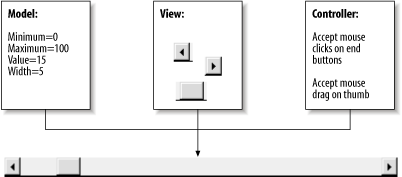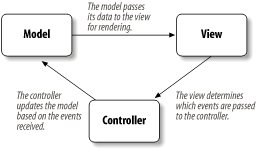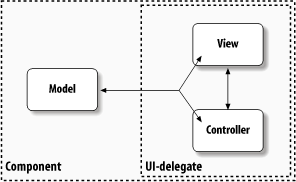1.4 The Model-View-Controller Architecture
| Swing uses the model-view-controller architecture (MVC) as the fundamental design behind each of its components. Essentially, MVC breaks GUI components into three elements. Each of these elements plays a crucial role in how the component behaves.
Figure 1-6 shows how the model, view, and controller work together to create a scrollbar component. The scrollbar uses the information in the model to determine how far into the scrollbar to render the thumb and how wide the thumb should be. Note that the model specifies this information relative to the minimum and the maximum. It does not give the position or width of the thumb in screen pixels the view calculates that. The view determines exactly where and how to draw the scrollbar, given the proportions offered by the model. The view knows whether it is a horizontal or vertical scrollbar, and it knows exactly how to shadow the end buttons and the thumb. Finally, the controller is responsible for handling mouse events on the component. The controller knows, for example, that dragging the thumb is a legitimate action for a scrollbar, within the limits defined by the endpoints, and that pushing on the end buttons is acceptable as well. The result is a fully functional MVC scrollbar. Figure 1-6. The three elements of a model-view-controller architecture 1.4.1 MVC InteractionWith MVC, each of the three elements the model, the view, and the controller requires the services of another element to keep itself continually updated. Let's continue discussing the scrollbar component. We already know that the view cannot render the scrollbar correctly without obtaining information from the model first. In this case, the scrollbar does not know where to draw its "thumb" unless it can obtain its current position and width relative to the minimum and maximum. Likewise, the view determines if the component is the recipient of user events, such as mouse clicks. (For example, the view knows the exact width of the thumb; it can tell whether a click occurred over the thumb or just outside of it.) The view passes these events on to the controller, which decides how to handle them. Based on the controller's decisions, the values in the model may need to be altered. If the user drags the scrollbar thumb, the controller reacts by incrementing the thumb's position in the model. At that point, the whole cycle repeats. The three elements, therefore, communicate their data as shown in Figure 1-7. Figure 1-7. Communication through the model-view-controller architecture 1.4.2 MVC in SwingSwing actually uses a simplified variant of the MVC design called the model-delegate. This design combines the view and the controller object into a single element, the UI delegate, which draws the component to the screen and handles GUI events. Bundling graphics capabilities and event handling is somewhat easy in Java, since much of the event handling is taken care of in AWT. As you might expect, the communication between the model and the UI delegate then becomes a two-way street, as shown in Figure 1-8. Figure 1-8. With Swing, the view and the controller are combined into a UI-delegate object So let's review: each Swing component contains a model and a UI delegate. The model is responsible for maintaining information about the component's state. The UI delegate is responsible for maintaining information about how to draw the component on the screen. In addition, the UI delegate (in conjunction with AWT) reacts to various events that propagate through the component. Note that the separation of the model and the UI delegate in the MVC design is extremely advantageous. One unique aspect of the MVC architecture is the ability to tie multiple views to a single model. For example, if you want to display the same data in a pie chart and in a table, you can base the views of two components on a single data model. That way, if the data needs to be changed, you can do so in only one place the views update themselves accordingly (Chapter 16 has an example that does exactly this). In the same manner, separating the delegate from the model gives the user the added benefit of choosing what a component looks like without affecting any of its data. By using this approach, in conjunction with the lightweight design, Swing can provide each component with its own pluggable L&F. By now, you should have a solid understanding of how MVC works. However, we won't yet spoil the fun of using MVC. Chapter 2 and Chapter 3 go into further detail about how you can use MVC to your advantage in even the simplest of applications. |
EAN: 2147483647
Pages: 289
- ERP System Acquisition: A Process Model and Results From an Austrian Survey
- Context Management of ERP Processes in Virtual Communities
- Distributed Data Warehouse for Geo-spatial Services
- Data Mining for Business Process Reengineering
- Relevance and Micro-Relevance for the Professional as Determinants of IT-Diffusion and IT-Use in Healthcare